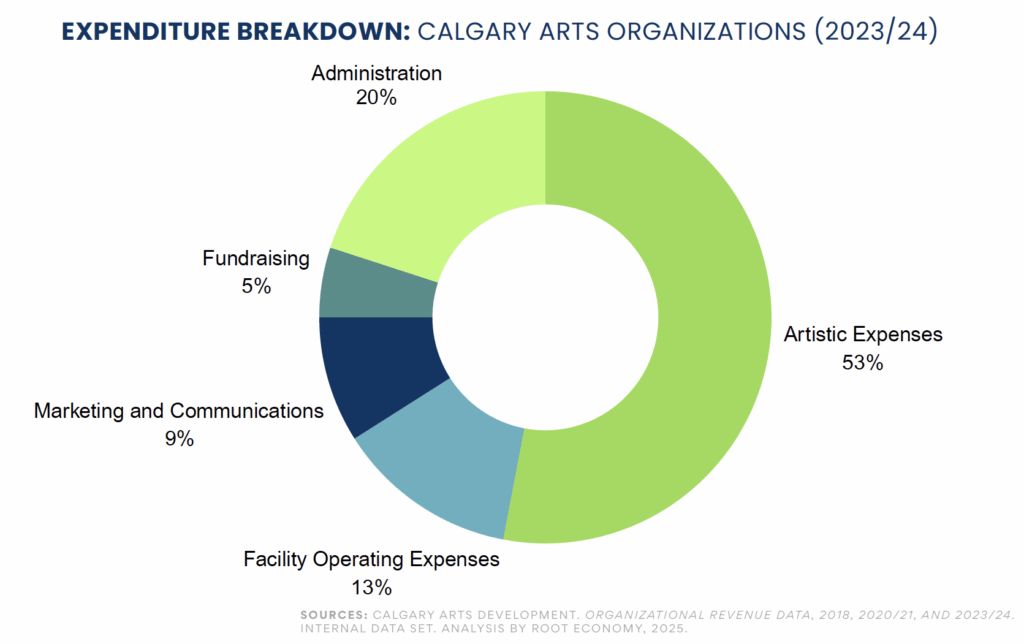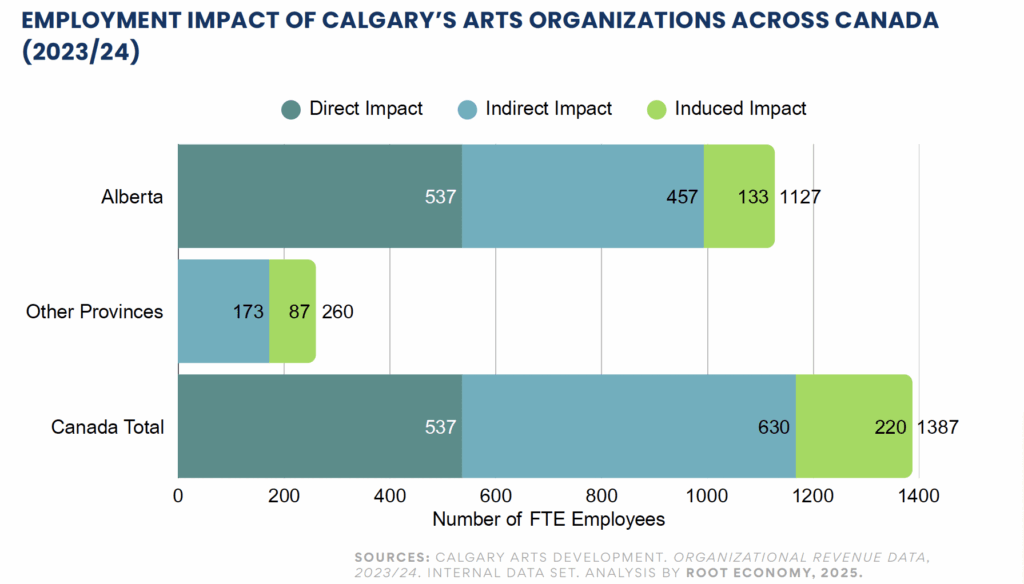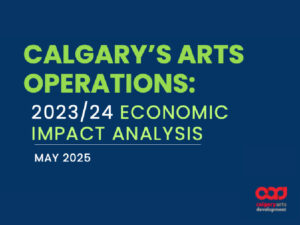Operating Grant Economic Impact Analysis
This report provides an Economic Impact Assessment of Calgary Arts Development Operating Grant Recipients (fiscal year beginning 2023).
In 2025, Calgary Arts Development contracted Root Economy, an independent economic consulting firm based in Calgary, Alberta, to conduct an independent economic impact assessment of Calgary arts organizations that receive Calgary Arts Development operating grant funding. The assessment measured recurring economic impacts resulting from the collective operating expenditures of 193 operating grant recipients.
This is an update to the 2018 and 2020 Operating Grant Program economic impact assessments.
This study continues to focus on quantifying four specific dimensions of economic impact: value-added GDP, labour income, employment and government revenue.
The findings show that Calgary’s funded arts organizations generated significant economic value, largely through their expenditures on labour, goods and services. Despite ongoing challenges following the COVID-19 pandemic, the sector demonstrated resilience, with many organizations prioritizing wages and employment.
In the fiscal year beginning 2023, 193 Calgary-based, not-for-profit arts organizations funded by Calgary Arts Development collectively:
- Generated $168 million in GDP
- Supported 1,387 full-time equivalent (FTE) jobs
- Contributed $31 million in tax revenue to municipal, provincial, and federal governments across Canada
These results reflect a significant rebound from pandemic-era lows, highlighting the resilience and economic vitality of Calgary’s arts sector.

In the fiscal year beginning 2023, 193 of Calgary’s arts organizations collectively reported expenditures of $154.5 million, marking a significant recovery and growth from previous years.
For context, total spending in the sector was approximately $120 million from 156 organizations in 2016/17, and dropped to $83 million from 160 organizations in 2020/21 during the height of the COVID-19 pandemic. This steady recovery and growth in expenditure points to the sector’s resilience and renewed activity across all core functions.

In 2023/24, the operating and sustaining capital expenditures of Calgary’s non-profit arts organizations supported an estimated 1,387 full-time equivalent (FTE) jobs across Canada.
Of these, 1,127 FTEs were sustained in Alberta, highlighting the sector’s strong local employment footprint. The remaining 260 FTEs were supported in other provinces, primarily through indirect and induced impacts linked to the purchase of goods, services and professional fees outside of Alberta.
- Direct employment totaled 537 FTEs, all of which were in Alberta, reflecting staff directly employed by Calgary-based arts organizations.
- Indirect impacts — jobs created through the sector’s supply chain, such as vendors, service providers and production partners — accounted for 630 FTEs, with 457 jobs in Alberta and 173 jobs in other provinces.
- Induced impacts, representing jobs supported by the household spending of those directly and indirectly employed, added another 220 FTEs, including 133 in Alberta and 87 in other provinces.
Tax Revenues
Calgary’s non-profit arts sector generated an estimated $31 million in gross tax revenues across municipal, provincial and federal levels of government in the fiscal year beginning 2023.
The majority of these revenues — approximately $23.4 million — were generated within Alberta, including:
- $1.9 million in municipal tax revenues
- $10.2 million in provincial tax revenues
- $11.4 million in federal tax revenues
In addition to Alberta-based impacts, the sector’s activity contributed an estimated $7.6 million in tax revenues outside the province, distributed across other provinces and the federal government. These revenues were generated indirectly through supply chain spending, employee expenditures and induced economic activity.
Volunteer Contributions
Volunteers play an essential role in sustaining Calgary’s arts organizations, contributing not just their time but also their expertise, energy and commitment to enriching the city’s cultural life.
In the fiscal year beginning 2023, more than 23,252 volunteers — including 1,574 board members and 21,678 community volunteers — supported arts programming, operations and events across the city. Their collective efforts ensured that organizations could deliver accessible, high-quality experiences despite limited staffing and resources.
Together, these volunteers donated approximately 538,473 hours of service. When valued at the average nonprofit sector wage of $38.70 per hour, this contribution amounts to an estimated $20.84 million in donated labour, equivalent to 259 full-time jobs. This remarkable level of civic engagement highlights the deep community investment in Calgary’s cultural sector and the critical role of volunteerism in its ongoing success.
Model Methodology
Root Economy used the Culture, Arts, Heritage and Sport Economic Impact Model (CAHSEIM) to estimate the economic contribution of Calgary’s arts organizations. CAHSEIM is a widely recognized and validated tool used across Canada to assess the economic impact of cultural and sport-related activities.
The model is grounded in Statistics Canada’s Supply and Use Tables (formerly Input-Output Tables), which provide the most detailed and coherent data on how goods and services are produced and consumed across the Canadian economy. These tables enable the measurement of direct, indirect and induced effects of spending and capture the full economic ripple effect across industries.
CAHSEIM incorporates data from the Interprovincial Input-Output Model, accounting for trade between provinces, regional production patterns and localized consumption. The most recent version is based on 2018 benchmark data. By incorporating indirect and induced impacts — such as increased consumer spending and supply chain effects — this analysis provides a comprehensive view of Calgary’s arts organizations’ economic contributions.
Root Economy applied a structured and conservative approach to this analysis. Verified expenditure data — covering both operating and sustaining capital costs — were gathered from Calgary arts organizations, classified by commodity and tailored to reflect Alberta-based spending only. This refined dataset was then modeled using CAHSEIM to simulate economic ripple effects across the provincial and national economies. The resulting outputs quantified the arts sector’s total economic contribution in terms of employment, GDP, labour income and tax revenues.
Download the full report here.
